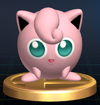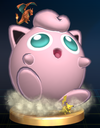Jigglypuff (SSBB): Difference between revisions
Mariogeek2 (talk | contribs) m (→Stats) |
mNo edit summary |
||
| Line 18: | Line 18: | ||
'''Jigglypuff''' ({{ja|プリン|Purin}}, ''Purin''), stylized as '''JIGGLYPUFF''' in Europe, is a character in ''[[Super Smash Bros. Brawl]]''. Confirmation of its appearance in ''Brawl'', along with its fellow veteran {{SSBB|Ness}} and the newcomer {{SSBB|Lucario}}, were [[List of leaks#Lucario/Jigglypuff/Ness leak|leaked]] before the game's release through a promotional video on the Japanese Wii website about [[sticker]] power ups; it was later officially [https://www.smashbros.com/wii/en_us/characters/hidden10.html confirmed] via {{SSBB|Smash Bros. DOJO!!}} on March 25, 2008. | '''Jigglypuff''' ({{ja|プリン|Purin}}, ''Purin''), stylized as '''JIGGLYPUFF''' in Europe, is a character in ''[[Super Smash Bros. Brawl]]''. Confirmation of its appearance in ''Brawl'', along with its fellow veteran {{SSBB|Ness}} and the newcomer {{SSBB|Lucario}}, were [[List of leaks#Lucario/Jigglypuff/Ness leak|leaked]] before the game's release through a promotional video on the Japanese Wii website about [[sticker]] power ups; it was later officially [https://www.smashbros.com/wii/en_us/characters/hidden10.html confirmed] via {{SSBB|Smash Bros. DOJO!!}} on March 25, 2008. | ||
Jigglypuff is voiced by Rachael Lillis in English via reused voice clips from ''Smash 64'', and by Mika Kanai in Japanese via voice clips last used in ''Smash 64'', ''Melee'', and some new ones. It is also voiced by Virginie Demians and Dina | Jigglypuff is voiced by Rachael Lillis in English via reused voice clips from ''Smash 64'', and by Mika Kanai in Japanese via voice clips last used in ''Smash 64'', ''Melee'', and some new ones. It is also voiced by Virginie Demians and Dina Kürten in French and German, respectively, replacing Guilaine Gilbert and Mara Winzer from ''Melee'', the latter two also voicing the {{SSBB|Pokémon Trainer}} in the French and German versions of ''Brawl''. | ||
Jigglypuff is ranked 36th on the ''Super Smash Bros. Brawl'' tier list in the bottom tier, a massive drop from its 3rd place ranking in the ''Melee'' tier list. Jigglypuff possesses incredible [[air speed|air mobility]], a good aerial game, some of the strongest edgeguarding, and one of the best recoveries in the game. However, the reason for its huge tier drop comes indirectly from the way its best attributes transitioned to ''Brawl''. Like {{SSBB|Captain Falcon}}, Jigglypuff's combos were more reliant on [[hitstun]] than other characters, and its excellent edguarding abilities came from ''Melee''{{'}}s much harsher disadvantage states. Jigglypuff has also had its KO moves nerfed, with Rest in particular suffering greatly; as opposed to KOing under 25% like it did in ''Melee'', it does not reliably KO until around 75%, and it is much harder to land due to the ability to cancel hitstun and the cast's reduced [[falling speed]]s preventing combos into it. In addition to this, Jigglypuff has terrible range, one of the worst ground games, the worst endurance of any character in ''Brawl'' (exacerbated by ''Brawl''{{'}}s defensive play), attacks that are punishable on landing, and poor air to ground transitioning due to its floaty physics preventing it from approaching safely in many situations. Such factors combine to result in awful [[matchup]]s and [[tournament]] results. Thanks to the huge nerfs and terrible transitioning to ''Brawl''{{'}}s meta, Jigglypuff holds distinction of having the largest tier list drop between ''Melee'' and ''Brawl''. What's more, Jigglypuff's position in Europe and Japan is worse than it is in America. In America, it is ranked as the 3rd worst character, while it is ranked as the 2nd worst and worst character in the game in Europe and Japan, respectively. | Jigglypuff is ranked 36th on the ''Super Smash Bros. Brawl'' tier list in the bottom tier, a massive drop from its 3rd place ranking in the ''Melee'' tier list. Jigglypuff possesses incredible [[air speed|air mobility]], a good aerial game, some of the strongest edgeguarding, and one of the best recoveries in the game. However, the reason for its huge tier drop comes indirectly from the way its best attributes transitioned to ''Brawl''. Like {{SSBB|Captain Falcon}}, Jigglypuff's combos were more reliant on [[hitstun]] than other characters, and its excellent edguarding abilities came from ''Melee''{{'}}s much harsher disadvantage states. Jigglypuff has also had its KO moves nerfed, with Rest in particular suffering greatly; as opposed to KOing under 25% like it did in ''Melee'', it does not reliably KO until around 75%, and it is much harder to land due to the ability to cancel hitstun and the cast's reduced [[falling speed]]s preventing combos into it. In addition to this, Jigglypuff has terrible range, one of the worst ground games, the worst endurance of any character in ''Brawl'' (exacerbated by ''Brawl''{{'}}s defensive play), attacks that are punishable on landing, and poor air to ground transitioning due to its floaty physics preventing it from approaching safely in many situations. Such factors combine to result in awful [[matchup]]s and [[tournament]] results. Thanks to the huge nerfs and terrible transitioning to ''Brawl''{{'}}s meta, Jigglypuff holds distinction of having the largest tier list drop between ''Melee'' and ''Brawl''. What's more, Jigglypuff's position in Europe and Japan is worse than it is in America. In America, it is ranked as the 3rd worst character, while it is ranked as the 2nd worst and worst character in the game in Europe and Japan, respectively. | ||
Revision as of 15:05, December 2, 2024
| Jigglypuff in Super Smash Bros. Brawl | |
|---|---|
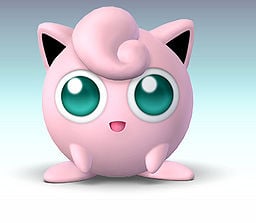 
| |
| Universe | Pokémon |
| Other playable appearances | in SSB in Melee in SSB4 in Ultimate |
| Availability | Unlockable |
| Final Smash | Puff Up |
| Tier | F (36) |
Jigglypuff (プリン, Purin), stylized as JIGGLYPUFF in Europe, is a character in Super Smash Bros. Brawl. Confirmation of its appearance in Brawl, along with its fellow veteran Ness and the newcomer Lucario, were leaked before the game's release through a promotional video on the Japanese Wii website about sticker power ups; it was later officially confirmed via Smash Bros. DOJO!! on March 25, 2008.
Jigglypuff is voiced by Rachael Lillis in English via reused voice clips from Smash 64, and by Mika Kanai in Japanese via voice clips last used in Smash 64, Melee, and some new ones. It is also voiced by Virginie Demians and Dina Kürten in French and German, respectively, replacing Guilaine Gilbert and Mara Winzer from Melee, the latter two also voicing the Pokémon Trainer in the French and German versions of Brawl.
Jigglypuff is ranked 36th on the Super Smash Bros. Brawl tier list in the bottom tier, a massive drop from its 3rd place ranking in the Melee tier list. Jigglypuff possesses incredible air mobility, a good aerial game, some of the strongest edgeguarding, and one of the best recoveries in the game. However, the reason for its huge tier drop comes indirectly from the way its best attributes transitioned to Brawl. Like Captain Falcon, Jigglypuff's combos were more reliant on hitstun than other characters, and its excellent edguarding abilities came from Melee's much harsher disadvantage states. Jigglypuff has also had its KO moves nerfed, with Rest in particular suffering greatly; as opposed to KOing under 25% like it did in Melee, it does not reliably KO until around 75%, and it is much harder to land due to the ability to cancel hitstun and the cast's reduced falling speeds preventing combos into it. In addition to this, Jigglypuff has terrible range, one of the worst ground games, the worst endurance of any character in Brawl (exacerbated by Brawl's defensive play), attacks that are punishable on landing, and poor air to ground transitioning due to its floaty physics preventing it from approaching safely in many situations. Such factors combine to result in awful matchups and tournament results. Thanks to the huge nerfs and terrible transitioning to Brawl's meta, Jigglypuff holds distinction of having the largest tier list drop between Melee and Brawl. What's more, Jigglypuff's position in Europe and Japan is worse than it is in America. In America, it is ranked as the 3rd worst character, while it is ranked as the 2nd worst and worst character in the game in Europe and Japan, respectively.
How to unlock
Complete one of the following:
- Play 350 VS. matches.
- Complete 20 or more events after completing The Subspace Emissary.
- Find Jigglypuff in The Swamp stage after completing The Subspace Emissary. It can be found through the first door after defeating the False Giant Diddy Kong. Note that this method does not show the challenger approaching screen, but a cutscene of Jigglypuff challenging the player shows instead.
The player must then defeat Jigglypuff on Pokémon Stadium 2.
Attributes
Jigglypuff is a character of the extremes, being the lightest and floatiest character in the game. With six jumps (albeit with the lowest height per jump), combined with the second fastest air speed (second only to Yoshi), the slowest falling speed, and Rising Pound, Jigglypuff dominates in aerial combat, and, with its forward aerial and back aerial moves, it can use the Wall of Pain technique very effectively allowing opponents to be K.O.ed at low percentages by being juggled off-screen. Jigglypuff's excellent aerial maneuverability makes up for its dash speed, which is the slowest in the game. A main disadvantage is that Jigglypuff's lightweight and floatiness means that it is sent flying rather easily in any direction. However, its light weight (combined with being floaty and small) also makes it immune to most chaingrabs. Despite this, because its air release has almost no horizontal distance, Jigglypuff can suffer from grab release combos by characters like Yoshi (though Jigglypuff has high vertical distance in its air release and can move one frame before anyone else's air release).
Jigglypuff has many attacks with decent knockback, but these attacks also have very low range (being light and poor ranged makes approaches very dangerous) and sometimes a medium amount of starting and/or ending lag. Its recovery is aided by Rollout, which is also a devastating approach attack on the ground, and the fact it never enters a helpless state makes the attack effective in the air too. However, Rollout, as with all charging approach attacks, can be predictable and can lead to a self-destruct if used carelessly. The move Rest provides invincibility frames which come out in one frame - faster than a shield - this allows for avoiding some dangerous situations. Rest can also deal up to 45% damage, and has vertical knockback and almost no horizontal knockback, guaranteeing a KO at around 75%, meaning Jigglypuff's vulnerability time after Rest is avoided if the attack hits. However, Rest leaves Jigglypuff extremely vulnerable if it misses. Jigglypuff also has a good array of strong albeit laggy smash attacks. Jigglypuff lacks projectiles, but its great aerial mobility helps it dodge many of them easily. Upon breaking its shield, Jigglypuff will be sent for a Star KO if there is no ceiling above it (see shield jump).
One of Jigglypuff's traits is that it has the slowest falling speed in the game, which is both beneficial and detrimental. This is beneficial because it allows for techniques such as the Wall of Pain, it significantly helps Jigglypuff's recovery, and it allows Jigglypuff to easily stay airborne in situations where ground play is dangerous. Jigglypuff's slow falling speed is detrimental because Jigglypuff cannot move from the air to the ground as quickly as most characters, limiting its options in most situations, and it makes vertically K.O.ing Jigglypuff very easy.
Changes from Super Smash Bros. Melee
Jigglypuff was heavily nerfed in the transition from Melee to Brawl. It's air game has been significantly weakened, as its air acceleration, formerly notorious for allowing it to weave in and out extremely quickly, has been largely reduced to be closer to that of the rest of the cast. This is further burdened by the cast generally having stronger recoveries and the changes to air dodging, which overall makes Jigglypuff's edgeguarding much less effective. Its most useful aerials from Melee, namely back aerial and up aerial, are not only adversely affected by these changes, but have received their own nerfs as well; the former has less range and more ending lag, while the latter deals less damage and is overall a less effective juggling tool. Jigglypuff's KO power has also been heavily decreased, as all its smash attacks are slower and weaker, while Rest's knockback has been significantly decreased to the point it can no longer KO under 70%, as opposed to KOing as low as 10% in Melee. Lastly, the introduction of hitstun canceling combined with the cast's universally decreased fall speeds have greatly hindered Jigglypuff's combo game, as some moves such as its up throw have completely lost their combo potential, and setups into Rest are much harder to perform.
Despite all the nerfs it has received, Jigglypuff did receive a few buffs. Its overall weight (while still low) has been significantly increased, giving it better survivability. Forward aerial has increased knockback, giving Jigglypuff a viable aerial attack to KO with at high percents. Down aerial is now also capable of tripping opponents, allowing it to be used for setups more effectively. Lastly, the introduction of DACUS slightly alleviates Jigglypuff's poor ground approach.
Overall, Jigglypuff's nerfs heavily outweigh its buffs, and the changes to Brawl hindered it more than they helped it, resulting in it going from one of the biggest threats in Melee to one of the weakest characters in Brawl.
Aesthetics
 Jigglypuff has a more subdued color scheme. Its eyes are a brighter teal, its hair curl at the end became smaller, and its feet became slightly larger.
Jigglypuff has a more subdued color scheme. Its eyes are a brighter teal, its hair curl at the end became smaller, and its feet became slightly larger. All of Jigglypuff's movements now make a squeaky, rubbery, and puffy sound (including midair jumps and attacks).
All of Jigglypuff's movements now make a squeaky, rubbery, and puffy sound (including midair jumps and attacks). Jigglypuff is significantly less vocal. It no longer vocalizes while taking knockback or during its first jump. This doesn't apply to the Japanese version, however.
Jigglypuff is significantly less vocal. It no longer vocalizes while taking knockback or during its first jump. This doesn't apply to the Japanese version, however.
 One of Jigglypuff's high knockback voice clips from Melee has been moved to Puff Up.
One of Jigglypuff's high knockback voice clips from Melee has been moved to Puff Up.
 Jigglypuff's yellow crown from Melee is replaced by the female protagonist's hat from Pokémon FireRed and LeafGreen.
Jigglypuff's yellow crown from Melee is replaced by the female protagonist's hat from Pokémon FireRed and LeafGreen.
Attributes
 As with the returning veterans, Jigglypuff's falling speed was reduced (1.3 → 0.98). Compared to the returning veterans, however, Jigglypuff falls faster. While this improves its endurance, it is more vulnerable to combos and chain grabs. Jigglypuff still maintains the lowest fall speed in the game.
As with the returning veterans, Jigglypuff's falling speed was reduced (1.3 → 0.98). Compared to the returning veterans, however, Jigglypuff falls faster. While this improves its endurance, it is more vulnerable to combos and chain grabs. Jigglypuff still maintains the lowest fall speed in the game. Jigglypuff's gravity is lower (0.064 → 0.05056).
Jigglypuff's gravity is lower (0.064 → 0.05056).
 Jigglypuff benefits the most from the new consideration of gravity on vertical knockback, having the biggest vertical knockback reduction, although it is more vulnerable to meteor smashes as a result.
Jigglypuff benefits the most from the new consideration of gravity on vertical knockback, having the biggest vertical knockback reduction, although it is more vulnerable to meteor smashes as a result.
 Jigglypuff is significantly heavier (60 → 68), which improves its horizontal survivability, although it is once again the lightest character in the game.
Jigglypuff is significantly heavier (60 → 68), which improves its horizontal survivability, although it is once again the lightest character in the game. Jigglypuff's traction is lower (0.09 → 0.0718), although relative to the cast, Jigglypuff now has the second highest traction with its traction being higher than all other returning veterans.
Jigglypuff's traction is lower (0.09 → 0.0718), although relative to the cast, Jigglypuff now has the second highest traction with its traction being higher than all other returning veterans. Jigglypuff's air speed is slower (1.35 → 1.269), no longer being the fastest in the game.
Jigglypuff's air speed is slower (1.35 → 1.269), no longer being the fastest in the game. Jigglypuff's air acceleration is significantly lower (0.19 → 0.05 (base), 0.09 → 0.08 (additional)), no longer being the highest in the game by a considerable margin, which is exacerbated by most returning veterans having their air acceleration increased. This significantly worsens Jigglypuff's approach, punish and spacing abilities that constituted its outstanding neutral game in Melee.
Jigglypuff's air acceleration is significantly lower (0.19 → 0.05 (base), 0.09 → 0.08 (additional)), no longer being the highest in the game by a considerable margin, which is exacerbated by most returning veterans having their air acceleration increased. This significantly worsens Jigglypuff's approach, punish and spacing abilities that constituted its outstanding neutral game in Melee.
 Though Jigglypuff's air acceleration is reduced much less while in its midair jump animation.
Though Jigglypuff's air acceleration is reduced much less while in its midair jump animation.
 In a similar vein to Captain Falcon and Ganondorf, the introduction of hitstun canceling prevents Jigglypuff from racking up a significant amount of guaranteed damage, and makes it much harder to land its finishing moves (Rest in particular).
In a similar vein to Captain Falcon and Ganondorf, the introduction of hitstun canceling prevents Jigglypuff from racking up a significant amount of guaranteed damage, and makes it much harder to land its finishing moves (Rest in particular). Jumpsquat is slower (5 → 6 frames).
Jumpsquat is slower (5 → 6 frames). Sidestep has less ending lag (FAF 28 → 26).
Sidestep has less ending lag (FAF 28 → 26). Sidestep has increased startup lag (frame 2 → 3), and unlike the rest of the veterans' sidesteps, its intangibility was not increased, making it the sidestep with the shortest intangibility in the game.
Sidestep has increased startup lag (frame 2 → 3), and unlike the rest of the veterans' sidesteps, its intangibility was not increased, making it the sidestep with the shortest intangibility in the game. Rolls have less ending lag (FAF 35 → 33).
Rolls have less ending lag (FAF 35 → 33). Forward roll has increased startup lag (frame 2 → 3).
Forward roll has increased startup lag (frame 2 → 3). In a similar vein to Yoshi, the removal of light shield hinders significantly Jigglypuff's shield size and makes easier to punish if Jigglypuff if Jigglypuff uses constantly shield, increasing the chances to break Jigglypuff's shield.
In a similar vein to Yoshi, the removal of light shield hinders significantly Jigglypuff's shield size and makes easier to punish if Jigglypuff if Jigglypuff uses constantly shield, increasing the chances to break Jigglypuff's shield. the removal of wavedashing hinders significantly Jigglypuff's ground approach as Jigglypuff no longer can improve it's speed in the ground for compensating it's awful ground speed , worsening it's offensive options on the ground.
the removal of wavedashing hinders significantly Jigglypuff's ground approach as Jigglypuff no longer can improve it's speed in the ground for compensating it's awful ground speed , worsening it's offensive options on the ground.
Ground attacks
- Neutral attack:
 Both hits have larger hitboxes (3.6u → 4.32u). The introduction of jab locking also improves its damage racking ability if the opponent misses a tech. Lastly, Jigglypuff can quickly repeat the first hit until it connects if the attack button is held.
Both hits have larger hitboxes (3.6u → 4.32u). The introduction of jab locking also improves its damage racking ability if the opponent misses a tech. Lastly, Jigglypuff can quickly repeat the first hit until it connects if the attack button is held. Its first hit has more ending lag (FAF 16 → 17).
Its first hit has more ending lag (FAF 16 → 17).
- Forward tilt:
 Forward tilt has more startup lag (frame 6 → 7).
Forward tilt has more startup lag (frame 6 → 7).
- Up tilt:
 Up tilt can KO earlier due to the generally slower falling speeds of the cast.
Up tilt can KO earlier due to the generally slower falling speeds of the cast. It has more startup and a shorter duration (frames 8-14 → 9-13). The changes to Brawl's physics also makes it significantly less useful for juggling.
It has more startup and a shorter duration (frames 8-14 → 9-13). The changes to Brawl's physics also makes it significantly less useful for juggling.
- Down tilt:
 Down tilt has more ending lag (FAF 30 → 31) and smaller hitboxes (3.6u/4u → 3u).
Down tilt has more ending lag (FAF 30 → 31) and smaller hitboxes (3.6u/4u → 3u).
- Dash attack:
 Jigglypuff is capable of cancelling the initial frames of its dash attack for a DACUS, slightly improving its otherwise slow ground game.
Jigglypuff is capable of cancelling the initial frames of its dash attack for a DACUS, slightly improving its otherwise slow ground game. It has more startup (frame 4 → 5).
It has more startup (frame 4 → 5).
- Forward smash:
 Forward smash has more startup (frame 12 → 16) and ending lag (FAF 45 → 55).
Forward smash has more startup (frame 12 → 16) and ending lag (FAF 45 → 55). It has lower knockback scaling (118 (clean)/105 (late) → 103/80), and its clean hit deals less damage (17% → 16%), hindering its KO potential.
It has lower knockback scaling (118 (clean)/105 (late) → 103/80), and its clean hit deals less damage (17% → 16%), hindering its KO potential.
- Up smash:
 Up smash's sweetspot now takes priority over its sourspot, making it easier to hit. Both are also larger (4u/6u → 4.8u/7.2u).
Up smash's sweetspot now takes priority over its sourspot, making it easier to hit. Both are also larger (4u/6u → 4.8u/7.2u). Up smash has much more startup (frame 7 → 16) and ending lag (FAF 45 → 54). It also has lower knockback scaling (110 → 100), and its sourspot deals less damage (14% → 13%), hindering its KO potential.
Up smash has much more startup (frame 7 → 16) and ending lag (FAF 45 → 54). It also has lower knockback scaling (110 → 100), and its sourspot deals less damage (14% → 13%), hindering its KO potential. Up smash's angle has been altered (90° → 87°).
Up smash's angle has been altered (90° → 87°).
- Down smash:
 Down smash's hitboxes are larger (4u/4.8u → 4.8u/5.6u).
Down smash's hitboxes are larger (4u/4.8u → 4.8u/5.6u). Down smash has more startup (frame 9 → 14) and ending lag (FAF 48 → 53).
Down smash has more startup (frame 9 → 14) and ending lag (FAF 48 → 53).
 It has an altered animation, where Jigglypuff appears to wind up for the attack, before returning to a standing position and winding up a second time and actually attacking, causing the animation to look unfinished.
It has an altered animation, where Jigglypuff appears to wind up for the attack, before returning to a standing position and winding up a second time and actually attacking, causing the animation to look unfinished.
 Down smash now sends grounded opponents sliding along flat surfaces even at percents where it would otherwise cause tumbling, including 999%. This prevents them from teching the move to survive, and allows it to take better advantage of edge slipping, but reduces its KO potential against opponents with high traction.
Down smash now sends grounded opponents sliding along flat surfaces even at percents where it would otherwise cause tumbling, including 999%. This prevents them from teching the move to survive, and allows it to take better advantage of edge slipping, but reduces its KO potential against opponents with high traction.
Aerial attacks
 All aerials except down aerial have less landing lag (20/10 frames → 15). Due to the removal of L-canceling, however, their landing lag is not fully compensated.
All aerials except down aerial have less landing lag (20/10 frames → 15). Due to the removal of L-canceling, however, their landing lag is not fully compensated. All aerials except neutral aerial auto-cancel earlier (frame 34 → 28 (forward), frame 25 → 23 (back), frame 37 → 35 (up), frame 39 → 38 (down)). Coupled with Jigglypuff's slower falling speed, this enables all of them to auto-cancel in a short hop.
All aerials except neutral aerial auto-cancel earlier (frame 34 → 28 (forward), frame 25 → 23 (back), frame 37 → 35 (up), frame 39 → 38 (down)). Coupled with Jigglypuff's slower falling speed, this enables all of them to auto-cancel in a short hop. All aerials except up aerial have gained the ability to lock opponents.
All aerials except up aerial have gained the ability to lock opponents. Jigglypuff's slower falling speed enables it to perform multiple aerials in a short hop such as two forward or back aerials.
Jigglypuff's slower falling speed enables it to perform multiple aerials in a short hop such as two forward or back aerials.
- Neutral aerial:
 Neutral aerial has a slightly longer duration (frames 6-28 → 6-29), less ending lag (FAF 50 → 44), and its clean hit has increased knockback (10 (base)/70 (scaling) → 20/90).
Neutral aerial has a slightly longer duration (frames 6-28 → 6-29), less ending lag (FAF 50 → 44), and its clean hit has increased knockback (10 (base)/70 (scaling) → 20/90). It deals less damage (12% (clean/9% (late) → 10%/6%), and its late hit has lower knockback scaling (80 → 70). It also auto-cancels later due to the move's longer duration (frame 29 → 30).
It deals less damage (12% (clean/9% (late) → 10%/6%), and its late hit has lower knockback scaling (80 → 70). It also auto-cancels later due to the move's longer duration (frame 29 → 30).
- Forward aerial:
 Forward aerial's clean hit has increased knockback (10 (base)/100 (scaling) → 30/108), allowing it to KO more effectively at high percents.
Forward aerial's clean hit has increased knockback (10 (base)/100 (scaling) → 30/108), allowing it to KO more effectively at high percents. Forward aerial has more startup lag with a shorter duration (frames 7-22 → 8-20), and more ending lag (FAF 35 → 37). Its late hit also deals less damage (7% → 6%) and knockback (10 (base)/80 (scaling) → 12/70).
Forward aerial has more startup lag with a shorter duration (frames 7-22 → 8-20), and more ending lag (FAF 35 → 37). Its late hit also deals less damage (7% → 6%) and knockback (10 (base)/80 (scaling) → 12/70).
- Back aerial:
 Back aerial has less startup lag (frame 9 → 8).
Back aerial has less startup lag (frame 9 → 8).
 As a result, the hitboxes now become active a frame before Jigglypuff actually kicks its foot, resulting in the move having a large disjoint for its first active frame.
As a result, the hitboxes now become active a frame before Jigglypuff actually kicks its foot, resulting in the move having a large disjoint for its first active frame.
 It has larger hitboxes (4u/4u/4.4u → 4u/4.5u/5u).
It has larger hitboxes (4u/4u/4.4u → 4u/4.5u/5u). Its hitboxes are no longer attached to Jigglypuff's leg but rather, they are now stationary. While this allows the move to cover a set area more consistently throughout the active duration of the move and it allows the move to cover more of Jigglypuff's body, it significantly decreases its range, as the position of the hitboxes was not fully compensated (z offset: 2.0/-0.4/0 → -12/-8/4). As a result, the move is now only slightly disjointed, making it a much less effective spacing tool.
Its hitboxes are no longer attached to Jigglypuff's leg but rather, they are now stationary. While this allows the move to cover a set area more consistently throughout the active duration of the move and it allows the move to cover more of Jigglypuff's body, it significantly decreases its range, as the position of the hitboxes was not fully compensated (z offset: 2.0/-0.4/0 → -12/-8/4). As a result, the move is now only slightly disjointed, making it a much less effective spacing tool. It has more ending lag (FAF 31 → 33).
It has more ending lag (FAF 31 → 33). It has decreased knockback scaling (100 → 90).
It has decreased knockback scaling (100 → 90).
 Altogether these changes combined with Jigglypuff's worse air mobility and the introduction of hitstun canceling reduce its effectiveness as a Wall of Pain.
Altogether these changes combined with Jigglypuff's worse air mobility and the introduction of hitstun canceling reduce its effectiveness as a Wall of Pain.
- Up aerial:
 Up aerial has less startup lag with a longer duration much like its Smash 64 counterpart (frames 9-12 → 8-16), and it has less ending lag (FAF 38 → 37).
Up aerial has less startup lag with a longer duration much like its Smash 64 counterpart (frames 9-12 → 8-16), and it has less ending lag (FAF 38 → 37). It now has three smaller hitboxes rather than one large hitbox (5.6u → 4u/4u/4u).
It now has three smaller hitboxes rather than one large hitbox (5.6u → 4u/4u/4u). Its angle has been altered (90° → 88°).
Its angle has been altered (90° → 88°). It deals less damage (12% → 9%). This hinders its KO potential, while the changes to Brawl's physics also significantly hinder its combo and juggling potential.
It deals less damage (12% → 9%). This hinders its KO potential, while the changes to Brawl's physics also significantly hinder its combo and juggling potential.
- Down aerial:
 Down aerial is now capable of tripping opponents at higher percents. Combined with the move's ability to auto-cancel in a short hop, this improves its setup potential. It also deals more total damage (14.74% → 16%) due to the changes to stale-move negation.
Down aerial is now capable of tripping opponents at higher percents. Combined with the move's ability to auto-cancel in a short hop, this improves its setup potential. It also deals more total damage (14.74% → 16%) due to the changes to stale-move negation. With the introduction of multipliers for hitlag and SDI in Brawl, down aerial has received a below-average hitlag multiplier (0.8×), but an above-average SDI multiplier (1.2×). This makes SDI more effective against the move, but gives opponents less time to execute it.
With the introduction of multipliers for hitlag and SDI in Brawl, down aerial has received a below-average hitlag multiplier (0.8×), but an above-average SDI multiplier (1.2×). This makes SDI more effective against the move, but gives opponents less time to execute it.
Throws/other attacks
- Grabs:
 Standing and dash grabs have less startup (frame 7 → 6 (standing), frame 12 → 11 (dash)) and ending lag (FAF 31 → 30 (standing), FAF 41 → 40 (dash)).
Standing and dash grabs have less startup (frame 7 → 6 (standing), frame 12 → 11 (dash)) and ending lag (FAF 31 → 30 (standing), FAF 41 → 40 (dash)).
- Pummel:
 Pummel is faster (30 → 20 frames).
Pummel is faster (30 → 20 frames).
- Forward throw:
 Forward throw deals less damage (12% → 10%), and its first hit no longer overrides the throw itself, severely decreasing the move's knockback (40 (base)/110 (scaling) → 100/30) and giving it a higher angle (361° → 55°) against grabbed targets as a result. This significantly worsens its edgeguarding and KO potential, going from the second strongest forward throw in Melee to among the weakest in Brawl.
Forward throw deals less damage (12% → 10%), and its first hit no longer overrides the throw itself, severely decreasing the move's knockback (40 (base)/110 (scaling) → 100/30) and giving it a higher angle (361° → 55°) against grabbed targets as a result. This significantly worsens its edgeguarding and KO potential, going from the second strongest forward throw in Melee to among the weakest in Brawl.
- Up throw:
 Up throw deals less damage (11% → 10%) and knockback (130 (base)/25 (scaling) → 110/30). While this would make it better for combos, the universally decreased falling speeds and the introduction of hitstun canceling have completely removed its combo potential, including the space animal slayer.
Up throw deals less damage (11% → 10%) and knockback (130 (base)/25 (scaling) → 110/30). While this would make it better for combos, the universally decreased falling speeds and the introduction of hitstun canceling have completely removed its combo potential, including the space animal slayer.
- Down throw:
 Down throw now consists of only one hit right before the throw, instead of five hits as Jigglypuff rolls on the opponent. However, the move still deals more total damage (1% (hits 1-4)/3% (hit 5)/2% (throw) → 4% (hit 1)/6% (throw)).
Down throw now consists of only one hit right before the throw, instead of five hits as Jigglypuff rolls on the opponent. However, the move still deals more total damage (1% (hits 1-4)/3% (hit 5)/2% (throw) → 4% (hit 1)/6% (throw)).
- Floor attack:
 Floor attacks deal consistent damage per hit (8%/6% → 6%).
Floor attacks deal consistent damage per hit (8%/6% → 6%).
Special moves
- Rollout:
 Rollout no longer causes helplessness when used in the air.
Rollout no longer causes helplessness when used in the air. Rollout has much less recoil when hitting an opponent, reducing the chance of Jigglypuff SDing when hitting an opponent near an edge.
Rollout has much less recoil when hitting an opponent, reducing the chance of Jigglypuff SDing when hitting an opponent near an edge. Jigglypuff can now slow down in the air by inputting in the opposite direction, reducing the chances of rolling offstage and SDing.
Jigglypuff can now slow down in the air by inputting in the opposite direction, reducing the chances of rolling offstage and SDing. Grounded Rollout has considerably lower knockback scaling (120 → 100) and launches at a higher angle (20° → 30°), noticeably hindering its KO potential.
Grounded Rollout has considerably lower knockback scaling (120 → 100) and launches at a higher angle (20° → 30°), noticeably hindering its KO potential. Jigglypuff does not vocalize during Rollout until it is fully charged.
Jigglypuff does not vocalize during Rollout until it is fully charged.
- Pound:
 Pound deals less damage (13% → 11%), hindering its KO potential.
Pound deals less damage (13% → 11%), hindering its KO potential. It has more startup (frame 12 → 13) with a longer total duration (FAF 45 → 46).
It has more startup (frame 12 → 13) with a longer total duration (FAF 45 → 46). It cannot be angled as much in the air.
It cannot be angled as much in the air.
- Sing:
 Sing now counts as three separate hitboxes rather than one hitbox which respawns three times. This means that if the opponent shields the first wave, they can now get hit by the other waves.
Sing now counts as three separate hitboxes rather than one hitbox which respawns three times. This means that if the opponent shields the first wave, they can now get hit by the other waves. Sing has more startup and significantly higher ending lag, with its first two waves having shorter durations (frames 28-35, 69-76, 113-125 → 29-33, 73-77, 122-134), and now triggers counterattacks. It can also no longer reset the sleep duration of an already asleep opponent, preventing it from being used to indefinitely stall them out.
Sing has more startup and significantly higher ending lag, with its first two waves having shorter durations (frames 28-35, 69-76, 113-125 → 29-33, 73-77, 122-134), and now triggers counterattacks. It can also no longer reset the sleep duration of an already asleep opponent, preventing it from being used to indefinitely stall them out. Its soundwaves are now only yellow instead of being colorful. Jigglypuff also now opens its eyes once the song is over instead of opening them at the last part of the song.
Its soundwaves are now only yellow instead of being colorful. Jigglypuff also now opens its eyes once the song is over instead of opening them at the last part of the song.
- Rest:
 Instead of using the flame effect, Rest applies a flower to the opponent, which causes much more damage (28% → 45%) if the opponent applies no button mashing. It also has one extra frame of intangibility (frames 1-26 → 1-27).
Instead of using the flame effect, Rest applies a flower to the opponent, which causes much more damage (28% → 45%) if the opponent applies no button mashing. It also has one extra frame of intangibility (frames 1-26 → 1-27). It has more startup (frame 1 → 2), and deals significantly less initial damage (28% → 15%) along with less knockback (78 (base)/120 (scaling) → 100/75), greatly reducing its KO potential and overall utility.
It has more startup (frame 1 → 2), and deals significantly less initial damage (28% → 15%) along with less knockback (78 (base)/120 (scaling) → 100/75), greatly reducing its KO potential and overall utility. Rest launches opponents at a vertical angle (361° → 88°), increasing its safety onstage if it KOs the opponent, but hindering its safety offstage and further reducing its KO ability near edges.
Rest launches opponents at a vertical angle (361° → 88°), increasing its safety onstage if it KOs the opponent, but hindering its safety offstage and further reducing its KO ability near edges. In the Japanese language, Jigglypuff gained a new voice clip for performing Rest again; the move's voice clip from Melee can still be heard when Jigglypuff is stunned, though it is difficult to hear due to breaking its shield usually causes a self-destruct.
In the Japanese language, Jigglypuff gained a new voice clip for performing Rest again; the move's voice clip from Melee can still be heard when Jigglypuff is stunned, though it is difficult to hear due to breaking its shield usually causes a self-destruct.
- Puff Up:
 Jigglypuff now has a Final Smash: Puff Up. Jigglypuff rapidly inflates itself to a gargantuan size and launches all opponents near it horizontally while saying "Jiggly!" before quickly deflating back to its normal size.
Jigglypuff now has a Final Smash: Puff Up. Jigglypuff rapidly inflates itself to a gargantuan size and launches all opponents near it horizontally while saying "Jiggly!" before quickly deflating back to its normal size.
Moveset
For a gallery of Jigglypuff's hitboxes, see here.
| Name | Damage | Description | ||
|---|---|---|---|---|
| Neutral attack | Jab (たたき) / Continuous Jab (つづけてたたき) | 3% | Two very quick, yet extremely short ranged slaps. Good for jab locking. Active on frames 5-6. | |
| 3% | ||||
| Forward tilt | Rolling Kick (まわしげり, Roundhouse Kick) | 10% | A spin kick. Short ranged. Can be angled, with no difference to damage. Can KO at the ledge at 141%. | |
| Up tilt | Back Kick (うしろあしげり) | 9% (clean), 8% (late) | Lifts its foot behind it, attacking upward. The clean hit only hits behind Jigglypuff, while the late hit can hit in front, albeit with minimal range. Active on frames 9-13. Good knockback, KOing from the ground at 126%. | |
| Down tilt | Leg Sweep (あしばらい) | 10% | Ducks down and sticks its foot out. Has average start-up (hitting on frames 10-12) and ending lag, but decent range for Jigglypuff. Mid-low knockback, cannot combo or KO effectively. | |
| Dash attack | Jiggly Ram (ダイビング, Diving) | 12% (clean), 8% (late) | Leaps forward with a headbutt. Hits on frame 5-15. KOs at 110% at the ledge, and 149% from the center of Final Destination. | |
| Forward smash | Lunge Kick (とびこみげり) | 16% (clean), 13% (late) | Slides forward while sticking its foot out. Short duration, but average startup (first hitting on frame 16) and ending lag, and deals strong knockback, KOing uncharged at 110% and fully charged at 70% from the center of Final Destination. | |
| Up smash | Headbutt (ずつき) | 15% (head), 13% (body) | Headbutts upward. Works well with the DACUS, which greatly enhances Jigglypuff's slow ground game, as it allows it to attack from a distance, with the up smash being a powerful vertical finisher. Active on frames 16-19. | |
| Down smash | Jiggly Split (りょうあしげり, Double-Footed Kick) | 12% | Puffs downward, kicking to both sides. Has short range, but deals decent knockback and launches at a perfectly horizontal angle, putting opponents in inconvenient places to recover. Active on frames 14-15. | |
| Neutral aerial | Jigglypuff Kick (プリンキック) | 10% (clean), 6% (late) | Sticks its foot out, shrinking in on itself a little. A very long sex kick. KOs at 145% at the ledge. | |
| Forward aerial | Front Kick (まえげり) | 12%/10% (clean), 6% (late) | Dropkicks forward. The clean hit's sweetspot is located closer to Jigglypuff, and is a decent finisher, KOing at 86% at the ledge and 122% from the centre of Final Destination. Active on frames 8-20. | |
| Back aerial | Spinning Back Kick (うしろげり) | 12% | A spin kick behind itself. Good for Wall of Pain and stage spiking, but KOs later compared to forward aerial. KOs at 132% at the ledge. | |
| Up aerial | Clean Sweep (なぎはらい) | 9% | Waves one arm above itself. Has a long duration (frames 8-16), but a small hitbox. Low knockback up to 100% gives it decent combo ability. Cannot KO from the ground until 170%. | |
| Down aerial | Spinning Kick (かいてんげり) | 2% (hits 1-8) | A spinning drill kick. Can cause tripping, allowing it to lead into Rest. All hits meteor smash grounded opponents, keeping them in place, while sending aerial opponents at a semi-spike angle. First hit starts on frame 5. | |
| Grab | Grab (つかみ) | — | Hooks the opponent with its left arm. Low range. | |
| Pummel | Grab Punch (つかみパンチ) | 3% | Slaps with its tuft of hair. Slow but highly damaging for a pummel. | |
| Forward throw | Bumper (バンパー) | 5% (hit 1), 5% (throw) | Puffs once, launching the opponent forward. Has very high base knockback, but very low knockback scaling. | |
| Back throw | Brain Buster (ブレーンバスター) | 10% | Back suplexes the opponent. Has similar knockback to forward throw. | |
| Up throw | Tornado Throw (たつまきなげ) | 10% | Spins once and throws the opponent up. Decent finisher near the top blast line. Jigglypuff's only throw that can KO in Sudden Death. | |
| Down throw | Grinder (ぐりぐり) | 4% (hit 1), 6% (throw) | Rolls back and forth on the opponent. | |
| Forward roll Back roll Spot dodge Air dodge |
— | — | ||
| Techs | — | — | ||
| Floor attack (front) Floor getups (front) |
6% | Spins its legs around while getting up, kicking in front and behind it. Short ranged. | ||
| Floor attack (back) Floor getups (back) |
6% | Spins its legs around while getting up, kicking in front and behind it. Short ranged. Makes a Rollout sound. | ||
| Floor attack (trip) Floor getups (trip) |
5% | Spins on its head and kicks around itself. | ||
| Edge attack (fast) Edge getups (fast) |
6% | Flips up and kicks. | ||
| Edge attack (slow) Edge getups (slow) |
6% | Slowly gets up and spins on both sides of itself. | ||
| Neutral special | Rollout | 8-18% | Charges up, and then rolls at opponent. Damage, velocity, and knockback determined by charge time. | |
| Side special | Pound | 11% | Punches forward, giving Jigglypuff some horizontal momentum. Launches opponents either upward if hit close to Jigglypuff, or at a reverse horizontal angle if hit with the tip of its arm, and deals high shield damage. In midair, it can be aimed vertically, allowing it to significantly aid Jigglypuff's recovery if used repeatedly. | |
| Up special | Sing | 5% (SSE) | Sings to produce up to three consecutive musical waves, which put close opponents to sleep. Can only affect grounded opponents. Enemies in The Subspace Emissary take damage from the waves instead. | |
| Down special | Rest | 15% | Takes a nap, producing a hitbox at the center of its body for one frame and undergoing a brief period of intangibility. It is active on frame 2, making it the fastest attack in Jigglypuff's arsenal, and deals powerful knockback, KOing Mario at 67% from the ground and King Dedede at 87%. However, it has very short range and an extremely long duration of 249 frames (more than 4 seconds), leaving it very punishable if it misses or fails to KO the opponent. | |
| Final Smash | Puff Up | 17% | Slowly puffs up. At the apex of the move, any characters touching Jigglypuff will be pushed away, then launched horizontally as it deflates. | |
Stats
| Stats | Weight | Dash speed | Walk speed | Traction | Air friction | Air speed | Air acceleration | Gravity | Falling speed | Jumpsquat | Jump height | Double jump height | Empty landing Lag |
|---|---|---|---|---|---|---|---|---|---|---|---|---|---|
| Value | 68 | 1.4 – Initial dash 1.1 – Run |
0.7 | 0.0718 | 0.0375 | 1.269 | 0.05 – Base 0.08 – Additional |
0.05056 | 0.98 – Base 1.372 – Fast-fall |
6 | 19.79264911 - Base ? - Short hop |
? | 3 |
Announcer call
English
Wii Remote selection sound
- Jigglypuff makes a bouncy noise and shouts.
On-screen appearance
- Comes out of a Poké Ball, then does a short, bouncy dance.
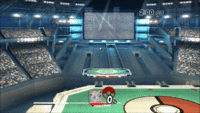
|
|---|
Taunts
- Up taunt: Spins on one leg around and says "Jigglypuff" while puffing up a little.
- Side taunt: Spins very fast on one leg then stops and has its arm pointed upward while looking in the direction it's pointing.
- Down taunt: Waves its arms up and then flattens and floats down. Based on Jigglypuff's "faint" animation in battles in the home console Pokémon games.
| Up taunt | Side taunt | Down taunt |
|---|---|---|
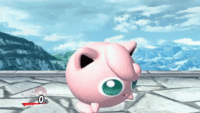
|
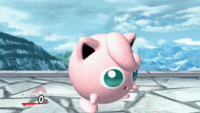
|
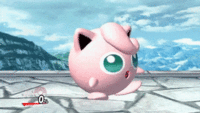
|
Idle pose
- Turns to look towards the left and then returns to normal position.
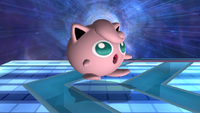
|
|---|
Crowd cheer
| English | Japanese | |
|---|---|---|
| Cheer | File:Jigglypuff Cheer NTSC Brawl.ogg | File:Purin Cheer JP Brawl.ogg |
| Description | Jig-gly-puff! | Pu-ri-n! |
| Pitch | Female | Group chant |
Victory poses
- Up: Jumps up two times, then does an aerial flip.
- Left: Attempts to bounce up, but ends up on its back.
- Right: Rests, then wakes up for a split second before resting again.
| Up | Left | Right |
|---|---|---|
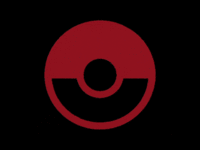
|
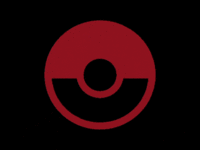
|
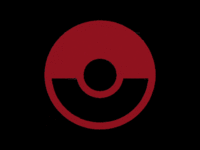
|
In competitive play
Most historically significant players
- See also: Category:Jigglypuff players (SSBB)
C7A - The only solo Jigglypuff player to reach notable success with the character, placing 33rd at Bushido Brawl Impact, tied for Jigglypuff's highest placing at a major. Considered the best Jigglypuff player in Europe and was considered to be one of the best Jigglypuff players in the world.
Dapuffster - Was considered the best Jigglypuff player in the world, placing 33rd at Pound 4, tied for Jigglypuff's highest placing at a major. He was one of the few good enough to gain recognition as a Jigglypuff player purely off his abilities. Living in the murderously strong NY/NJ area however, he was never a PR contender, and he would eventually drop Jigglypuff for Diddy Kong.
Hungrybox - While he never remotely approached his level of greatness in Melee, he was a respectable player in Brawl despite using the drastically nerfed Jigglypuff and not having much practice in the game, being good enough to once get ranked on the Florida Power Rankings using Jigglypuff alongside King Dedede. Even when accounting for multi-character usage, no other player ever got ranked on a high level Brawl PR using Jigglypuff.
Tier placement and history
Jigglypuff has always been seen as one of the worst characters in Brawl; right away players noticed its significant nerfs to key attributes, and its terrible transitioning into Brawl's physics and gameplay changes. Over the years, despite Jigglypuff's still strong aerial game, air camping abilities, and recovery, metagame developments for Jigglypuff were startlingly barren. Jigglypuff was also perhaps the most unpopular character in Brawl competitive play, lacking the dedicated playerbase other low tier characters had, having barely any notable players, and was a very rare sight at even low level local tournaments with casual players. Jigglypuff's abysmal matchup spread further compounds this, with nearly all top- and high-tiered characters having multiple options to combat its abysmal approaches and overwhelm it in return. As such, Jigglypuff has always been ranked among the four worst characters in the game in all iterations of the BBR's tier list. Some players even believed Jigglypuff, rather than Ganondorf, was the worst character in the game, since the latter at least possesses a fearsome punish game and Ganondorf players have achieved notably better results despite his perceived overall worse matchup spread. In fact, the Japanese playerbase ranked Jigglypuff as the worst character on their tier list, though the BBR did not follow suit in their final Brawl tier list, instead ranking Jigglypuff as the third worst character, above Ganondorf and Zelda.
In Solo Modes
Classic Mode
In Classic Mode, Jigglypuff can appear as an opponent or ally in Stage 3 if it has been unlocked along with Pikachu, Pokémon Trainer, and Lucario on Pokémon Stadium 2 or Spear Pillar (with the latter available if it has been unlocked). Jigglypuff can also appear as an opponent in Stage 11, but only if it hasn't appeared in Stage 3.
All-Star Mode
In All-Star Mode, Jigglypuff is fought in Stage 18 alongside Pikachu, Pokémon Trainer, and Lucario on Pokémon Stadium 2 or Spear Pillar (with the latter available if it has been unlocked).
Event Matches
Solo Events
- Event 29: All-Star Semifinal Regulars: Jigglypuff is one of the opponents fought in this event. All opponents are characters that were unlockable from the original Super Smash Bros. game.
- Event 35: The Visitor to Flat Zone: As Mr. Game & Watch, the player must defeat Peach, Toon Link, and Jigglypuff on Flat Zone 2. All three opponents have the "Game & Watch" effect on their models.
Co-Op Events
- Co-Op Event 16: Jigglypuff's Great Comeback: Jigglypuff and Mr. Game & Watch, who are tiny, must defeat Lucas and Ness, who are giant, on Castle Siege. As the stage changes to different backgrounds, Jigglypuff will grow and Lucas and Ness will shrink.
- Co-Op Event 21: The True All-Star Battle: Both players select a character and take on the entire roster on Battlefield.
Congratulations Screens
Role in The Subspace Emissary
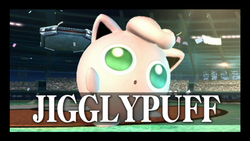
Jigglypuff is an optional character in The Subspace Emissary, much like Toon Link and Wolf, who consequently does not have a role in the story.
To unlock it, first the player must complete The Subspace Emissary, whereupon an extra door in The Swamp can be found that links to Pokémon Stadium 2, where Jigglypuff is performing a song. Jigglypuff is then fought and, if defeated, is unlocked (if not already unlocked) and joins the player's party.
Exclusive stickers
These stickers can only be used by Jigglypuff or a select few including it.
- Charizard: [Arm, Leg] Attack +10
- Deoxys: [Slash] Attack +10
- Entei: [Flame] Attack +20
- Goldeen: [Leg] Attack +4
- Groudon: [Flame] Resistance +14
- Gulpin: [Electric] Attack +16
- Jigglypuff: [Body, Spin] Attack +31
- Jirachi: [Arm, Leg] Attack +7
- Meowth: [Slash] Attack +5
- Metagross: Launch Resistance +23
- Mew: [Body, Spin] Attack +4
- Moltres: [Flame] Attack +20
- Pokémon Trainer: [Arm, Leg] Attack +13
- Staryu: [Specials: Direct] Attack +3
- Togepi: [Body, Spin] Attack +11
- Torchic: [Flame] Attack +8
- Weavile: [Slash] Attack +5
Trophies
Jigglypuff's main and Final Smash trophies can be obtained by clearing Classic Mode and All-Star mode respectively with Jigglypuff.
- Jigglypuff
- A Balloon Pokémon. It invites opponents in close with its big, round eyes, then puts them to sleep with a calming song. The secret to the song's unfailing efficacy is Jigglypuff's ability to sing on the wavelength that will make its opponent the sleepiest. It also uses Attract to infatuate opponents who touch it. It uses a Moon Stone to evolve into Wigglytuff.
: Pokémon Red/Blue
: Pokémon Diamond/Pearl
- Puff Up
- Jigglypuff's Final Smash. It wills its body to get bigger and bigger and bigger. It can't move, and it can't attack--all it can do is get bigger while everyone else looks on. However, it's invulnerable, and it overpowers all attacks to gradually push its opponents off the screen. It's a very simple technique, but how it's used determines its effectiveness.
: Super Smash Bros. Brawl
Alternate costumes

| ||||
Gallery
Using its up aerial on Spear Pillar.
Using its back aerial on Smashville.
Taunting alongside Ness on New Pork City.
Using its up aerial near Ganondorf on Smashville.
Trivia
- Masahiro Sakurai stated that Jigglypuff, along with Toon Link and Wolf, were almost cut from Brawl due to time constraints and their late consideration for inclusion in the game, hence why they are excluded from and cannot be unlocked while playing through the main Subspace Emissary story.[1]
- Jigglypuff is also the only veteran who does not have a Subspace Emissary role.
- Likely because of its late inclusion, there is an oddity with the character selection screen in The Subspace Emissary. While all other characters are ordered by when they joined the Smash series (minus Zero Suit Samus due to sharing a slot with Samus), Jigglypuff is grouped with the other late-inclusions following the initial Brawl newcomers rather than with the Super Smash Bros. veterans.
- Jigglypuff is also the only veteran who does not have a Subspace Emissary role.
- In the American and PAL versions, Jigglypuff has only two KO screams — one for a Star KO and another for a normal KO. Jigglypuff is the only character in Brawl to have a single blast line KO clip.
- Jigglypuff’s official artwork is nearly identical to its Melee Smabura-Ken artwork. The only difference is that its arms are pointed slightly inward rather than outward.
- In the Japanese version of Brawl, Jigglypuff has some additional voice clips that don't have equivalents in the American/PAL versions:
- Jigglypuff vocalizes when using its first jump.
- Jigglypuff contains two soft-damage yells and two hard-damage yells, the latter being used in the next game.
- Jigglypuff uses two different voice clips when getting KO'd past the blast lines.
- Most of Jigglypuff's voice clips were simple imports from Melee. One voice clip, involving it screaming "Jiggly!", was imported and can be heard in the sound test, but is not used by Jigglypuff at all in the game.
- Brawl is the only Super Smash Bros. game in which Jigglypuff does not have a bow as one of its costumes.
- It is also the only Super Smash Bros. game in which Jigglypuff uses its Shiny color for one of its costumes.
- Jigglypuff and Mr. Game & Watch are the only veterans who can no longer become helpless via any of their special moves in their transitions from Melee to Brawl. Their helpless animations, which are carried over from Melee, can be seen briefly during their air dodge animations.
- Jigglypuff and Luigi are the only characters that players are not forced to play as in single-player Event Matches.
- Jigglypuff, along with Diddy Kong, Pokémon Trainer, and the Ice Climbers, are the only characters in Brawl that do not clap in the Results screen after losing or at the No Contest screen.
- Jigglypuff is the only character to have a slightly different damage meter portrait than their official artwork. The official artwork has it standing upright while the damage meter portrait has it tilted.
- Brawl is the first game in the Super Smash Bros. series in which Jigglypuff cannot be unlocked after completing Classic Mode (or its Smash 64 counterpart, 1P Game) with any character. This unlock criteria is instead given to Marth.
- Jigglypuff's trophy description states that it uses Attract to infatuate opponents who touch it, which is incorrect. Attract is a status move that causes infatuation, while Cute Charm is an ability that causes infatuation on physical contact, and one which Jigglypuff can have.
- A CPU Jigglypuff will repeatedly use Pound when it uses all its jumps but doesn't get back to the stage.
External links
- Jigglypuff's page at Smash Bros. DOJO!!.
- Jigglypuff Character Guide on SmashBoards
- Jigglypuff's hitbox size of each of its moves
References
| Fighters in Super Smash Bros. Brawl | |
|---|---|
| Veterans | Bowser · Captain Falcon · Donkey Kong · Falco · Fox · Ganondorf · Ice Climbers · Jigglypuff · Kirby · Link · Luigi · Mario · Marth · Mr. Game & Watch · Ness · Peach · Pikachu · Samus · Yoshi · Zelda / Sheik |
| Newcomers | Diddy Kong · Ike · King Dedede · Lucario · Lucas · Meta Knight · Olimar · Pit · Pokémon Trainer (Charizard · Ivysaur · Squirtle) · R.O.B. · Snake · Sonic · Toon Link · Wario · Wolf · (Zero Suit Samus) |




